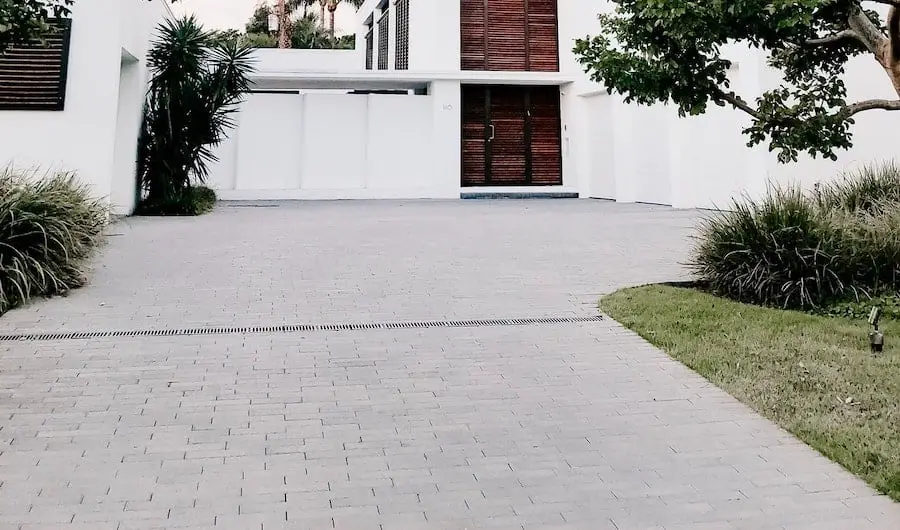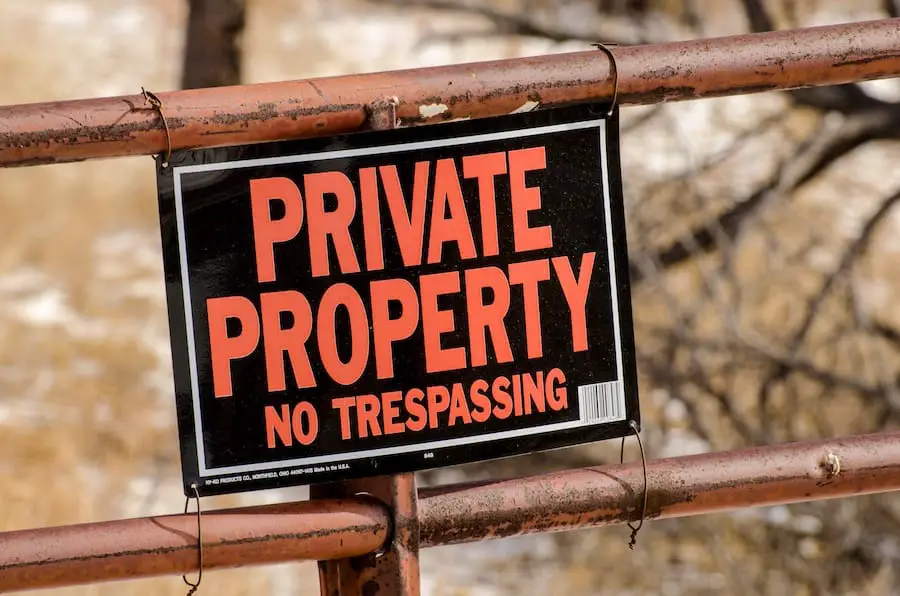Looking for a way to keep neighbors off your driveway? Whether it’s a one-time occurrence or something that’s happening every day, it’s a pain to have neighbors constantly parking on your driveway or curb. Your driveway is part of the private property of your home and is afforded the same benefits of the Fourth Amendment that your car and home are. Knowing that, let’s take a look at how to keep neighbors off your driveway:
There are several ways to keep your neighbors off your driveway. They include posting “No Trespassing” signs, building barriers like fencing, planting shrubbery, and installing an entrance gate. Discussing the situation with your neighbor, involving the police, and taking legal action may also be necessary.
Trespassing is the act of intruding on a person or property without permission. Since your driveway is private property, any unauthorized use can be perceived as trespassing.
But it’s not as simple as that. Read on to learn more.
Is a Driveway Private Property? What About a Driveway Apron?

A driveway is part of a home’s main property and is thus considered private property.
Another way to describe a driveway is a short, private road leading to your home.
In either case, your driveway is afforded all benefits of the Fourth Amendment that your house and car receive. Strangers who enter your driveway can also be trespassing under certain circumstances.
A driveway apron, on the other hand, is the portion of the driveway that extends from the street pavement to the sidewalk. Homeowners do not own the driveway apron portion of their driveways. It is thus not private property as it is in the public right-of-way. Despite this, they are responsible for the maintenance and overall upkeep of the apron.
What’s Considered Trespassing on Someone’s Driveway?
Trespassing in real estate loosely means the act of entering on a property without permission or a legal right to be there. The law’s specifics are variable between the states and in different jurisdictions. However, intruding on someone else’s driveway can be a form of trespass. This is especially true if the property has fencing, gates, or signs that explicitly say “Private Property” or “No Trespassing”.
Trespassing can be committed on foot or in a vehicle. Once someone is ordered off the property by the owner and he refuses to leave, they are now trespassing.
Trespassers must have some level of intent. They cannot have crossed the driveway accidentally or been under the impression that they could use it. The homeowner should install signage that indicates that the land is private property so that trespassers know they are trespassing.
If a driveway is open with no fence or gate and no signs posted, anyone can walk or drive onto the driveway with no legal ramifications. It is too difficult to prove intent to trespass in these situations. Once the homeowner tells them to leave, it is a different story. At this point, they are effectively trespassing, and law enforcement can be called.
If the trespasser steals, damages, or destroys something, you can take them to court. At this point, it becomes a matter of civil trespassing, and you will have to prove intent or that you told them to leave before the theft or destruction.
Law enforcement may enter the driveway and walk from the car to the front door. If the officer wanders around the property without the owner’s knowledge or permission and begins peeking in windows, this is police trespassing. The officer is unlawfully searching, and any evidence collected would be inadmissible in court. If something illegal is in plain sight, officers can come onto your property without a warrant.
Can a Neighbor Walk on My Driveway?
Your driveway is considered private property, so your neighbor cannot walk on it unless you permit him. If your neighbor continues to traverse your property, he can be regarded as trespassing.
Ways to Keep Neighbors off Your Driveway
Here are some strategies for dealing with a neighbor who regularly walks on your driveway without permission.
1. Talk to your Neighbor
First, consider the actual problem: is it your neighbor walking on the driveway, or is it his kids playing on the driveway?
Have you had a conversation with your neighbor about the issue already?
If you have not had a conversation with your neighbor, start there. Explain how you feel about the situation and what your concerns are. This is the time to be clear and assertive about not wanting any trespassing, while at the same time remaining respectful and polite as you ask him to stop coming onto your property uninvited.
2. Put Up a “No Trespassing” Sign

You may want to take this time to put up “No Trespassing” signs in obvious locations that they will not miss. These are an affordable and effective solution to indicating that trespassers are not welcome on your property, and gives you ground to take legal action if you decide to do so.
Regulations for signs vary by state. Some require that you have signs along your property line and at every entrance to the property. Make sure that you familiarize yourself with the regulations of where you live.
3. Put Up a Barrier
There is also the option to build a barrier. This may be a fence or a natural barrier such as a living fence or wall of shrubbery. A physical barrier will indicate to your neighbors that you do not want them on your property.
Make sure you consult local building laws before any installations to make sure you remain compliant.
4. Use Motion-Detection Surveillance and Deterrents
Another option to monitor for unwelcomed trespassing is to install motion-activated security cameras. These will allow you to capture every instance of trespass. The footage will help support your claims should you need to seek legal action.
Other options may include motion-activated lighting, or, if you want to go that extra mile, you can also install motion-activated water sprinklers. These will act as an effective deterrent, especially if your neighbor has ill intentions.
5. Guard Dogs
If you’re a dog owner or just like dogs, then a great option would be get a guard dog or train your dog to bark at intruders. Dogs are excellent deterrents to trespassing as they have large teeth and loud barks. Their loud barking will alert neighbors and those passing by.
6. Issue a Letter of No Trespass
You can also issue your neighbor, or any trespasser, a “Letter of No Trespass.” This is a legal requirement particularly if you are considering legal actions.
Before writing up your own Letter of No Trespass, check with your local police service if they have an official template that can be used. Alternatively, in your letter you must:
- Clearly address the individual trespassing (it would be preferable if you know the name and address of the individual)
- Cleary state that the individual is not allowed to enter or remain on your property and the enforceable time period.
- Indicate the address of your property.
- Inform the trespasser that you may take legal action if they do not comply.
- Sign and date.
- Be able to provide evidence that the notice was delivered to the trespasser. Either deliver it in the presence of a law enforcement agent or deliver it by registered mail or through a legal service. Always retain a copy and in some instances, it may be advisable to send a copy to your local police to retain for records.
7. Get Local Mediation
If you are keen on maintaining a functional relationship with your neighbor or salvaging a deteriorating one, you can enlist the assistance of a third-party mediator.
Mediators can be found in your local community service centers. They will set up a meeting with you and your neighbor and give both of you an opportunity to speak freely. They will mediate the entire process and try to assist you in reaching a resolution that is acceptable to both parties.
How to Stop Cars from Turning Around in Your Driveway?
Not only is it annoying to have cars turning around in your driveway, but it can cause damage if they bump into your parked cars or leave tire marks on the driveway. If it’s a narrow driveway, larger vehicles like campers or those with trailers may drive on the lawn. The headlights shining into your living room at night can be like an annoyance and could also be invasion of privacy.
Not to mention the risk to the health and life of your children and pets playing on the driveway. The drivers may not see them if they are in their blind spots.
You can stop cars from using your driveway to turn around by installing a motion-detection alarm, making the driveway less accessible (buy using one or more options highlighted below), parking on the end of the driveway or by simply putting up a “No Turn Around” sign.
One of the best ways to stop cars from turning around in your driveway is to make it less appealing. You can use a motion-activated alarm that will alert you with light and sound when a car enters the driveway. The light and sound will also serve to deter the driver from accessing your driveway.
Narrowing the entrance to the driveway is an option that will make the driveway less accessible to intruders, but this will also affect you as the homeowner.
Other options to make the driveway less accessible include installing a beam or overhead bar, installing a gate, or installing chains at the entrance to your driveway. These are great ways to deter drivers from turning around in your driveway. However, this method has an obvious downside: you also would have to deal with the obstacles every time you want to access your own driveway.
If you have a short driveway, you can try parking at the very end of the driveway so that there is no room for someone to turn around. We don’t recommend this fix for longer driveways as it would be more of an inconvenience for you to walk the distance to and from the car.
The easiest way to stop cars from turning around in your driveway is to place a “No Turn Around” sign at the entrance. Doing so will signal drivers that they need to find another location to turn around in.
Is it Rude or Illegal to Use Someone’s Driveway to Turn Around?
Typically the act of turning around in someone’s driveway happens so quickly that the homeowner barely has time to notice, if they notice at all. For the most part, doing a quick turnaround is not illegal. Though, there can be exceptions to this rule.
Some municipalities may have laws against using private driveways for turning around. In this case, it would be illegal, no matter how quickly you do it, to turn around in someone’s driveway.
If the homeowner has “Private Property” or “No Trespassing” or “No Turn Around” signs posted anywhere on the property, then turning around in their driveway would be considered trespassing. Additionally, if they have a gate or other barrier, it would also be considered trespassing.
Rude, on the other hand, is a subjective term, but it can be considered rude to turn around in someone’s driveway. If your headlights shine into their windows, you could be disrupting their daily activities or even violating their privacy.
If you drive a wider vehicle or are hauling a trailer, you have the potential to drive on the homeowner’s lawn. Not only is this rude, but you could be required to pay for the damages done to the landscaping. It is best to be quick and careful about turning around in someone’s driveway.
When in doubt, ask yourself: “Would I consider it rude if drivers were turning around in my driveway?”
How to Block Off a Driveway?
There are several ways to block off your driveway, depending on what you are trying to prevent from happening. Physical barriers and signs are the most common methods of blocking a driveway.
If you have a lot of foot traffic on your driveway, you may want to consider building a fence along your driveway or planting shrubbery. The landscaping will let everyone know that they are not welcome unless invited. Let the landscaping do the talking for you!
To keep cars from turning around in your driveway, you can install a gate, chains, or a bar at the entrance to the drive. The only problem with this method is that you will have to deal with the barrier every time you need to enter or exit the driveway.
Perhaps the easiest solution is to place “No Trespassing” signs along the property line. Doing so will indicate to everyone that it is private property and cannot enter without permission.
Conclusion
Your driveway is an extension of the private property of your home. There are many ways in which you can keep trespassers off your property, including:
- Building fences
- Planting shrubbery
- Installing entrance gates
Stopping people from turning around in your driveway can be as easy as posting a “No Turn Around” sign.


